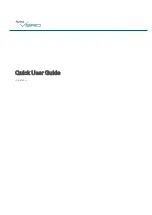
SF1000E
ANALOGUE PHOTO DETECTOR LITE
SETTING THE ADDRESS
Detectors can be addressed using a special hand-held programming unit or they can be auto-addressed by the control panel after
they have been installed (the implementation of the auto-addressing feature depends on the control panel’s manufacturer).
Addresses may be selected from a range from 1 to 240, although, of course, each device on the loop must have a unique address.
Figure 1 - View of the detector on its base.
*Product operates down to 15 V, but without LED indication.
TELEDATA S.R.L.
- Via Giulietti 8a, 20132, Milan, Italy
www.Teledata-i.com
L20-LV100-4001 (v2.1)
GENERAL DESCRIPTION
This type of detector (figure 1) continuously samples the air in the protected area to provide the earliest warning of fire and yet offers
a high level of false alarm rejection.
The digital communication protocol employed by the monitoring control panel provides high rates of information exchange in combi-
nation with comprehensive features that ensure fast and secure responses.
This device
benefits from a “Double Dust Trap” incorporated into the design of the smoke entry ports, hence limiting potential con-
tamination and extending periods between maintenance without compromising sensitivity of response. These detectors are designed
for open area protection and must only be connected to control panels that use the proprietary analogue-intelligent addressable
communication protocol for monitoring and control.
The centrally positioned red LED indicator provides 360° visibility and thus does not require any orientation during installation.
INSTALLATION
This photo detector must be used in combination with compatible control panels employing the communication protocol. The location
of detectors should follow recognised national or international application codes of practice.
The detector may be mounted on any of the following bases:
adaptor base / deep adaptor base
Universal adaptor base / deep adaptor base
adaptor base with shorting clip / deep adaptor base with shorting clip
Universal adaptor base with shorting clip / deep adaptor base with shorting clip
Bases supplied with a metal shorting clip installed between the two negative terminals allow more flexibility when connecting detec-
tors to the loop and permits the continuity of the loop cabling to be tested after installation and prior to the detectors being fitted.
Connections to the base terminals are polarity sensitive thus please check by referring to the wiring diagram in figures 2, 3,
4 and 5!
Figure 2 - adaptor base and deep adaptor base loop wiring.
Figure 3 - Universal adaptor base and deep adaptor base loop
wiring.
SENSITIVITY SETTINGS
A choice of four sensitivity levels are available which can be set via the hand-held programming unit or by panel selection (if pro-
vided). Level 1 is most sensitive, level 4 is least sensitive.
TECHNICAL SPECIFICATIONS
Power supply
*
from 18 V (min) to 40 V (max)
Average standby current consumption
70 uA @ 24 V
Remote output max current consumption
(externally limited)
20 mA
Operating temperature range
-30 °C / +70 °C (no icing)
Humidity
95% RH (no condensation)
Height (standard base included)
54 mm
Diameter
110 mm
Weight (standard base included)
130 g
Note: Before installing this device please thoroughly read
this leaflet and refer to the applicable European Standards and National
Codes of Practice (e.g. BS5839-1:2002 for UK) for guidance on location, spacing and acceptable use. Also seek guidance from the
compatible control panel instructions to ensure appropriate design criteria and configuration specifications are followed.
REMOTE OUTPUT CAPABILITY
Remote output capability is available as a standard feature so a remote indication lamp or a compatible platform sounder (check
power requirements) may be wired to the base terminals.
If other equipment is connected to the remote output, its supply current must be eventually limited by using an adequate
resistor. Consult the TECHNICAL SPECIFICATIONS table and assess the external device current absorption’s value.




















